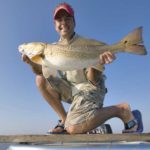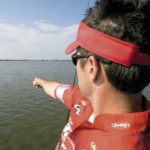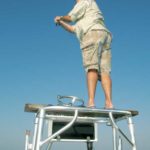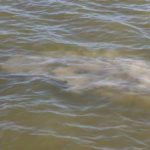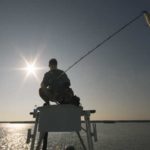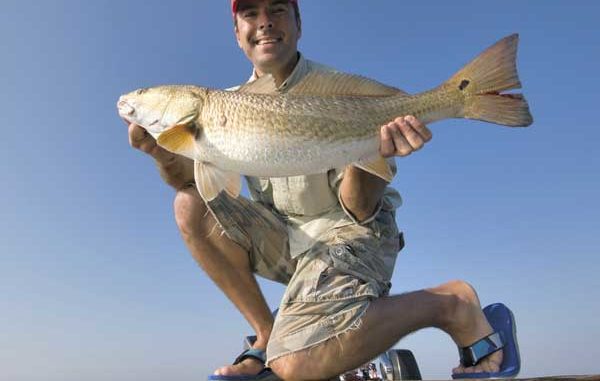
Add a tower to your boat, and you’ll rule the redfish world.
I felt like a king surveying his empire as Kris Culpepper gassed up his boat at the Venice Marina. However, looking at the expressions I was getting from those in the boats around me made me wonder if the king had no clothes. They wiped their eyes and did double takes as they gazed up at me. The fact that I was royally doing my best to imitate the King of Carnival waving from the top of his float only made the early morning sight that much more unusual.
Had Culpepper and I been gassing up in coastal Texas rather than coastal Louisiana, we wouldn’t have even raised one eyebrow because tower boats are a common sight in that part of the country. In Louisiana, they are an anomaly.
Culpepper and his brother Jonathan are pros from Houston who fish the FLW Wal-Mart Redfish Series and Oh Boy! Oberto Redfish Cup tournament trails. Those who follow the redfish tournaments will recognize them as being the champions of the 2007 FLW Western Division event in Lafitte.
That wasn’t their only win of 2007, though. Team Culpepper also came in on top at the Western Division tournament at Rockport, Texas.
The Culpepper brothers owe a lot of their recent success to a 21-foot Majek RFL series boat they purchased after it had already been retrofitted with an 8-foot tower directly over where the center console used to sit.
“We didn’t always fish from the tower boat,” said Kris Culpepper. “We fished out of a regular bay boat in 2003, 2004 and 2005. Then we switched to a tower boat in 2006 and 2007. When we look back at our results, we can see a big change. The tower boat hasn’t been responsible for all of it. I think the big change was because of what we learned about redfish by having a bird’s-eye view.”
Kris Culpepper and I were in Venice to throw some of the new Berkley saltwater baits to visible redfish, and, anomaly or not, he brought along his tower boat to make the job of seeing the reds as easy as possible. The wide-eyed anglers who thought us funny would just have to get used to the sight of a tower boat in Louisiana. After what I saw, they just might become a more common sight.
Kris Culpepper pointed his tower boat toward the Wagon Wheel right after leaving the harbor, and to my surprise the tower didn’t lean the least bit as he made the turn. This particular boat was rigged with the steering console at the top of the tower, and we were both riding up on the platform.
“A tower boat is a compromise,” he said as my confidence in the boat grew with every turn. “They’re not the fastest boats, and they’re rough out in open water, but in the right situation — calm backwaters — they offer a tremendous advantage. The way Jon and I look at it is that it’s just another tool in our redfish arsenal. We’re willing to sacrifice speed and ride because of its advantages.”
The obvious advantage of a tower boat is at once apparent to anyone who has stood on his trolling motor bracket or ice chest while sight casting to reds. Imagine multiplying the 2-foot advantage of an ice chest times four.
“I haven’t been in too many situations where the extra height has been a disadvantage,” said Jon Culpepper. “The higher you go, the larger your field of vision expands. Say you’re sight casting from a boat deck — you might only be able to see out 15 feet in any direction from the boat. Well, you get on top of that tower, and you can see out a lot farther than that.”
While the tower is an obvious advantage in height, that advantage can be offset somewhat on a calm and sunny day. That’s why the Culpepper brothers say the most important advantage they’ve discovered about the tower is for sight casting to reds on a cloudy day.
Jon Culpepper explained the cloudy-day advantage.
“We can see out to about 60 feet on a sunny day,” he said. “An angler on a casting platform can see out to about 30 feet on a sunny day. A cloudy day reduces both anglers’ fields of visions. But our field is reduced from 60 feet to 40 feet. The guy on the casting platform, his vision goes from 30 feet down to 10 feet.”
That 20-foot sight advantage is more than enough for the Culpeppers to overlook the previously stated disadvantages of speed and ride. While those are the primary shortcomings of a tower boat, there are some other less obvious factors of which those thinking about adding a tower to their boats should be aware.
One of the disadvantages that is easily overlooked is that the welds on the tower have to be constantly maintained because they can crack after a rough day on the water. And one disadvantage that might not even be realized until it’s too late is that the towers are sometimes too high to pass under swing bridges or canals with overhead obstructions.
“There are ways around each of those,” said Kris Culpepper. “Always keep an eye out for the cracked welds, and build a tower that can break away and flip down. Jon and I can unbolt ours into two sections. We can lay the top section down when towing the boat and to get under stuff out on the water.”
Kris Culpepper and I didn’t have any obstacles to pass under on our way to the Wagon Wheel, and once we made it in, all the advantages that the Culpeppers mentioned came to life right before my eyes.
As we ran through the shallow ponds, Kris Culpepper couldn’t contain his excitement. He pointed out about 20 or 30 fish in the first pond, none of which were seen by me because I didn’t know exactly what I was looking for. The more he pointed and explained, the more my eyes were trained to see what he saw.
“The first thing you’ve got to look at is the bottom more so than the fish,” he said. “When you can see the bottom and know what it looks like, you can tell instantly when there is something different, which usually winds up being a redfish.
“Mostly what you’re looking for when you first enter a pond are the mud boils left behind by darting fish. You should also keep your eyes out for deeper, more pronounced wakes that are typical of big reds. Once you get used to seeing a redfish wake, there’s no mistaking it for a mullet wake.”
After selecting a shoreline to fish, Kris Culpepper killed the big motor and reached to his right. He pulled out a 4-foot section of a 2×12 wooden plank that had metal brackets on the bottom. Before I could even ask him what it was far, he had instructed me to step aside so he could put the plank on top of the tower.
“The higher the better,” he said as he grabbed his rod and reel and jumped up on top of the plank.
Before I could even complain about having to stand on top of the plank with him, he was excitedly calling out individual fish and making casts toward them. His second cast was rewarded with a resounding thump, and he drove the hook home into the jaw of a 15-pound red.
The sight of him fighting the bull red from the top of that tower was one of the most unusual battles I had ever seen on the water. I couldn’t watch both, so I decided to keep an eye of the fish as it jumped as high as I had ever seen a redfish jump. The next thing I knew, he slung the fish over the side of the boat and right into my lap.
“From up here, you’ve got to get these fish under control as quickly as possible,” he explained. “That’s why we use Fenwick Intercoastal rods matched with Abu Garcia Revo Inshore reels. This combination is built for the rigors of battling big reds, and it allows Jon and me to control the fish rather than having the fish control us.”
After talking me up to the top of the casting platform that he had secured to the top of the tower, Culpepper began an on-the-water seminar on spotting fish from the tower.
We identified redfish as we drifted down the shoreline by noticing the coloration of the bottom to be just a little bit different. We identified redfish by seeing the tops of their backs flash in the sunlight, and we saw identified redfish by seeing them levitating just below the surface of the water.
Each fish we spotted got equal opportunity to engulf our pearl 4-inch Berkley Saltwater Gulp Alive Shrimp. While some of the fish tried to put as much distance between themselves and our tower boat as possible, many couldn’t resist the fake shrimp bouncing around right in front of them.
After catching more than enough reds for this particular outing, Kris Culpepper expanded the on-the-water seminar by showing me what they look for during tournament practice that allows them to put the full advantage of the tower boat in their corner once the event begins.
“We look for fish during practice,” he said, “but more importantly we look for places where the fish are going to go once the fishing pressure increases. The main things we look for are contour changes — things like mud humps from old, eroded marsh islands, troughs, guts, anything that’s different about the bottom. Being in the tower makes spotting these bottom changes a lot easier.”
When the pressure hits, redfish will pull to these different areas because they feel more secure in the relatively deeper water found in these types of areas. And in the case of the troughs and guts, the Culpeppers know exactly where fish will enter and leave a pond. It’s not just about finding fish. It’s about knowing what the fish will do and where they will go once all the boats start showing up.
After showing me a couple guts and depressions, Culpepper cranked the boat and moved into a shallow pond that was buffeted from the wind. We weren’t able to catch the wind, so he climbed down to the deck and put the trolling motor in the water while leaving me at the top of the tower.
“Jon and I fish like this a lot in Louisiana when we can’t get the boat to drift,” he said. “One of us stays in the tower while the other one goes down to run the trolling motor. It’s always best to have both of us in the tower, but when we can’t, it’s better to have one up there than none at all. Whichever one of us is in the tower will sight cast, and the one down on the deck will blind cast with a Berkley Powerbait Beetle Spin Mullet or a spoon.”
If the advantages of modifying your boat so that it has a tower just don’t seem like they’re important enough for fishing in Louisiana where the reds have bullish attitudes, consider this special tip from Jon Culpepper.
“We get in a lot of thick hydrilla in Louisiana when we fish over there,” he said. “The reds will get in potholes back in the mats. By being up in our tower, we’re better able to not only see the potholes back in the grass, but we’re also able to look down into the holes to spot the fish. It’s like looking at a bucket from the side. You might see a couple inches down the opposite side. But if you step up on a ladder, you can see all the way to the bottom of that bucket and anything that’s inside of it.”
In the end, it’s not so much the tower that’s the advantage — it’s the height. The tower is simply a tool for achieving the height. And as anyone who’s ever fallen off a ladder or a couple stacked ice chests to the bottom of his boat can tell you, the advantage of height is often overshadowed by the instability of the means used to achieve the height.
That’s where a stable tower is going to pay back the cost to modify your boat. You won’t wind up King of Carnival, but you’re buddies will soon be calling you King of Reds.
